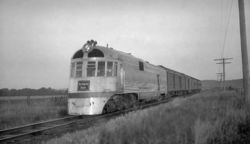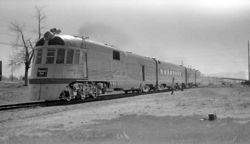General Pershing Zephyr

The General Pershing Zephyr was the ninth of the Chicago, Burlington and Quincy Railroad's Zephyr streamliners, and the last built as an integrated streamliner rather than a train hauled by an EMD E-unit diesel locomotive. It was constructed in 1939 with bodywork and passenger cars by Budd Company and diesel engine, electric transmission, power truck, and other locomotive equipment by General Motors' Electro-Motive Division. Because its intended Kansas City, Missouri to St. Louis, Missouri route passed near the birthplace and boyhood home of famous World War I General John J. Pershing, the train was named after him. The power car was named Silver Charger, after Pershing's horse Charger, while the passenger cars were named after U.S. Army badges of rank—Silver Leaf, Silver Eagle, and Silver Star.
Unlike previous Zephyrs, the General Pershing Zephyr was completely non-articulated; each car was self-contained and joined to the next by couplers, rather than shared trucks. The inflexibility of the articulated layout had been recognised; it was hard to lengthen, shorten, or replace parts of the train. The route did not require a high-capacity train nor a powerful locomotive, so the General Pershing Zephyr returned to the pattern of the first Pioneer Zephyr, being a power/baggage car and three trailers.
The power car, 9908 Silver Charger, was unique. It utilised the new EMD 567 V-12 engine developing 1,000 hp, like half of the contemporary EMD E3. It had one Martin Blomberg-designed E-unit A1A passenger truck at the front, driving the outer axles and with a center idler axle, and an unpowered trailing truck, giving it the unusual wheel arrangement of A1A-2. The back half of the power car was a baggage area.
The train ran its assigned route until World War 2 disrupted things in 1942, following which the trainset ran many different routes. As 9908 Silver Charger was really a separate locomotive, it continued in service hauling other trains after the rest of the streamlined trainset was withdrawn. In this form it lasted in service until 1966, following which it was donated to the Museum of Transportation in St. Louis, Missouri.
The diner-lounge-observation car Silver Star was sold to AMAX Iron Ore Corporation in 1974 and given to Mt Newman Mining (now part of BHP Billiton) in Western Australia and renamed Sundowner. It was used for many years as passenger accommodation on the fortnightly supply train to the mines. As at 2006, it is still used for VIP and inspection trains.
References
- Pinkepank, Jerry A. (1973). The Second Diesel Spotter's Guide. Kalmbach Publishing Co., Milwaukee, WI. ISBN 0-89024-026-4.
- Lotz, David. General Pershing Zephyr. Downloaded on December 24, 2004.
Limited production and export locomotives built by EMD | |
|---|---|
| Electrics | SW1200MG · AEM-7 · GM6 · GM10 · GF6C |
| Industrial, military, export and narrow gauge | Model 40 · DDM45 · DHI · GMDH-1 · GMDH-3 · MRS-1 · GA8 · G8 · G12 · G16 · G26 · NF110 · NF210 · JT42CWR (Series 66) · JT42HW-HS · GT46MAC · GT22HW · GT46PAC |
| Streamliners | M-10000 · M-10001 · M-10002 · M-10003-6 · Pioneer Zephyr · General Pershing Zephyr · Green Diamond · Flying Yankee · Aerotrain |
| Experimentals | 1800 hp B-B |
| See also: List of EMD locomotives | |

